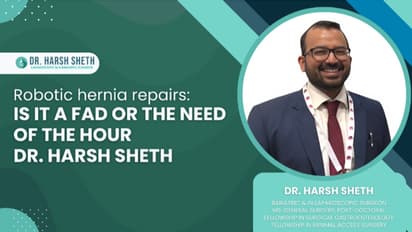Robotic hernia repairs: Is it a fad or the need of the hour: Dr. Harsh Sheth

Synopsis
Robotic surgeries imply surgeries through tinier incisions, minimal blood loss and rapid recovery from the surgery.
Dr. Harsh Sheth, a leading Advanced Laparoscopic and Bariatric Surgeon in Mumbai expresses his views on robotic hernia repair, whether it is a fad or the need of the hour. Though considered safe, open hernia surgeries come with their share of complications such as infection at the surgical site, bleeding, pain, mesh rejection, hernia recurrence, injury to nearby organs, chronic pain, fluid accumulation, respiratory problems, and blood clots. Postoperative complications after hernia repair imply more discomfort, additional treatment and a longer recovery period.
On the other hand, robotic surgeries imply surgeries through tinier incisions, minimal blood loss and rapid recovery from the surgery. He elaborates robotic surgery refers to advanced surgical procedures leading to improved outcomes and better patient recovery experiences. He adds that robotic surgery is capable of repairing all types of hernias viz. femoral, umbilical, and incisional and hiatal hernias. He has successfully performed several robotic hernia repair surgeries.
Dr Harsh Sheth is a leading bariatric surgeon in Mumbai, with over a decade of experience performing gastrointestinal and bariatric surgeries with a minimally invasive approach. He treats patients at Saifee Hospital, Sir HN Reliance Foundation Hospital, Breach Candy Hospital and Jaslok Hospital in Mumbai.
Ms. Vishaka Goyal, co-founder of ClinicSpots, a doctor discovery and healthcare platform asserts Dr. Harsh Sheth’s surgical expertise and experience. She states, ‘Dr. Harsh Sheth is well-versed in performing minimally invasive bariatric and GI surgeries including hernia repairs. He is very composed and calm in dealing with patients. He focuses on relieving patient’s issues in the best possible manner.’
Robotic surgery is performed via a computer-enabled interface. A robotic hernia repair surgery requires very tiny incisions in the surgical site to insert the specialized instruments and a high-definition three-dimensional camera. The surgeon accesses the view from the console and manages the robotic arm movements for hernia repair. Robotic surgery is never autonomous, and is fully under the control of the operating surgeon.
The surgeon performs the surgery using specially designed robotic arms while controlling the robotic arm movements through a special console. This interface also offers a 3D magnified view of the surgical site for better vision and ensures more precision in performing the surgery.
It also has a wrist-like interface i.e. the robotic arm offers seven degrees of freedom: left, right, up, down, pitch, yaw, grip, and rotational axis. Thus, it offers the surgeon a considerable advantage in accessing potential spaces such as the pelvis and retromuscular plane for repairing the hernia.
Human access to the hernias in the abdomen and groin areas is challenging, considering the limited scope of penetration within the abdominal wall. In such instances, a robotic arm offers dexterity and ergonomic benefits when performing the surgery.
Dr. Harsh Sheth states, ‘The wrist of the robotic arms enables the surgeons to reach areas of the hernia repair that are difficult to reach with conventional approaches, overcoming the limitations of a surgeon using traditional laparoscopic instruments.’
Furthermore, the robotic arms enable impeccable suturing in these areas, ensuring a thorough hernia repair. The robots can easily also accomplish the task of placing the mesh within the abdominal wall.
Also, he has noted reduced complications in hernia repair surgery when comparing robotic hernia surgery with laparoscopic or open surgery. He states, ‘Robotic hernia surgery takes less time to perform while there is minimal blood loss. Also, I have observed fewer surgical site infections. The patients recover sooner and better. Hence, they can be discharged earlier than open hernia repairs, at times even on the day of surgery.’
Conclusion
Robotic hernia repair is gaining preference worldwide. Moreover, the robotic platform can perform complicated hernia repair surgeries that are deemed challenging and difficult to perform via the open or laparoscopic approach. Robotic hernia surgeries are precise and accurate in performance and, hence, relatively safe and reliable. If performed by a well-versed surgeon, the robotic surgery can successfully repair complicated hernias, especially inguinal and ventral hernias. Robotic hernia repair surgeries are not a fad but are here to stay.
About Dr. Harsh Sheth:
Dr. Harsh Sheth is a successful and dynamic surgeon and a specialist in robotic and laparoscopic surgeries. He performs various procedures, such as gastro-intestinal surgeries, hernia repairs, HPB, splenectomy, and bariatric surgeries. He is a member of many important medical associations and has noteworthy research and publications in his name.
To schedule an appointment or inquiry with Dr. Harsh Sheth, please reach out to the following contact:
Genèse Clinic
G-14/15 8th Floor, Everest Building, Tardeo Rd, Janata Nagar, Tardeo, Mumbai, Maharashtra 400034
Contact no. 9137080299